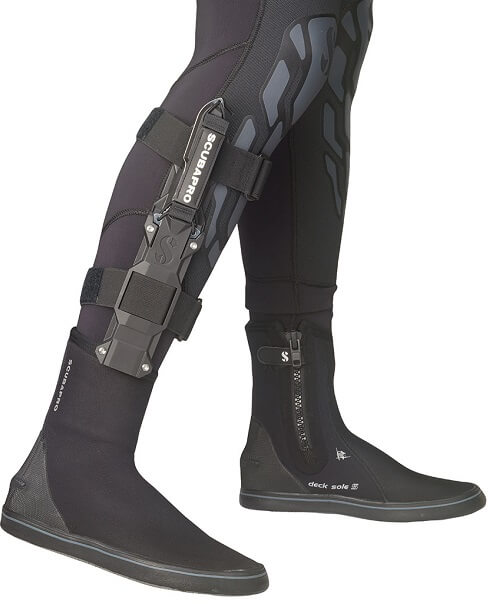How to Choose the Best Dive Knife
Better to have a knife and not need one, than to need a knife and not have one.
So goes the saying, and there is a lot of truth to it. The diving knife is an indispensable tool for serious divers. Offered in a variety of styles and sizes, sporting both long and short blades made of durable, corrosion-resistant metals and featuring a choice of cutting edges to handle different cutting tasks, a diving knife is a must-have item for any dive bag. The only question is, which dive knife is best for you?
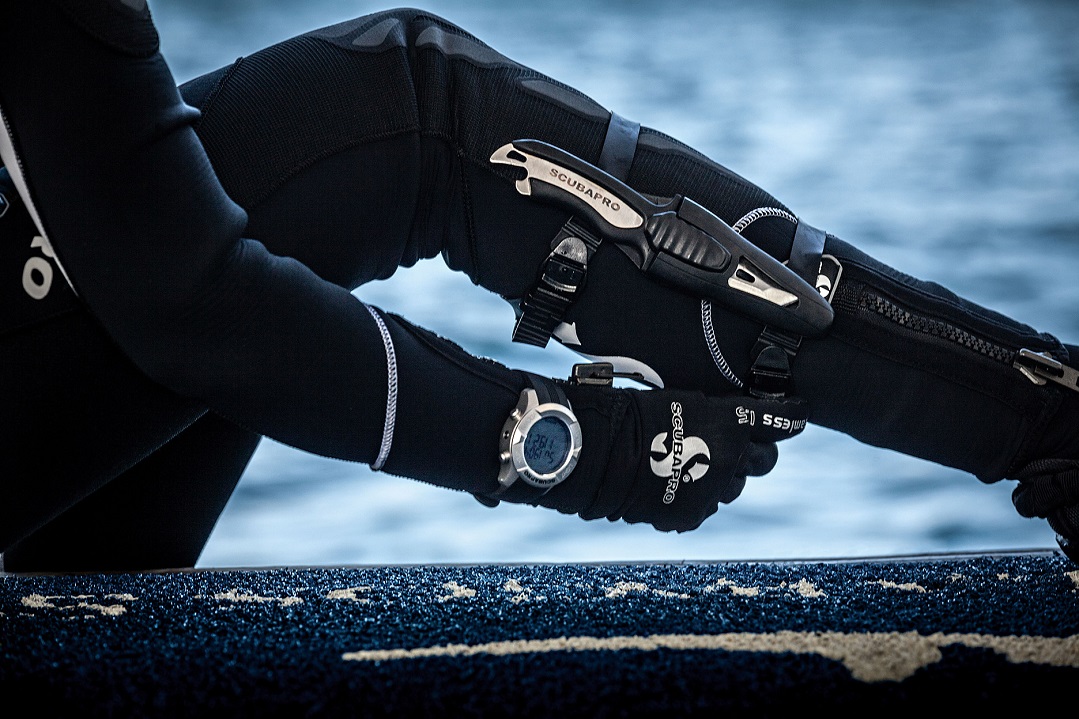
Scuba Knife Size
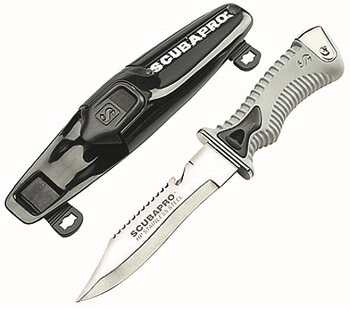 The first question you probably want to ask is, where do you intend to carry your scuba dive knife? Your answer will determine the size of dive knife you choose. Dive knives range from the traditional full-sized scuba diver's knife that you generally strap to your lower leg, to compact scuba knives that can be mounted on a BCD pocket or secured to a HP hose.
The first question you probably want to ask is, where do you intend to carry your scuba dive knife? Your answer will determine the size of dive knife you choose. Dive knives range from the traditional full-sized scuba diver's knife that you generally strap to your lower leg, to compact scuba knives that can be mounted on a BCD pocket or secured to a HP hose.
The K6 is a good example of a traditional-style full-sized all-purpose diver's knife. Its big 15 centimeter blade and ergonomic grip handle comes with an injected molded sheath and two quick-adjusting buckle straps that mount easily on the lower leg.
At the other end of the spectrum is a diver knife like the White Tip. With a blade length of about 6.4 centimeters and an overall length of just over15 centimeters, this type of dive knife is compact enough to attach to a hose or a BCD as a primary knife, or to stow in an easy-to-reach pocket as a back-up cutting tool.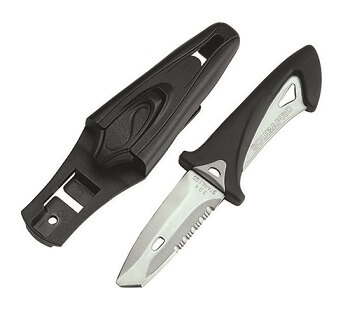
Diving Knife Materials
Stainless Steel Diving Knives
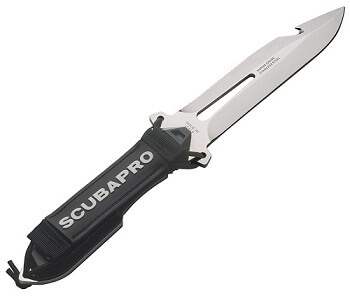 Stainless steel is the most common alloy used in the manufacturing of dive knife blades. The majority of dive knives are made of either Grade 304 stainless steel or Marine Grade 316 stainless steel.
Stainless steel is the most common alloy used in the manufacturing of dive knife blades. The majority of dive knives are made of either Grade 304 stainless steel or Marine Grade 316 stainless steel.
Grade 304 hard-tempered stainless steel is a very versatile metal that is used in a variety of outdoor applications. It offers resistance to surface oxidation and provides a good cutting edge. Because it is a little softer than Marine-Grade 316 stainless steel, a Grade 304 blade needs to be sharpened more frequently to maintain its good cutting edge. The stainless steel version of the Mako is a good example of a diving knife made with Grade 304 stainless steel.
Marine Grade 316 stainless steel is similar to Grade 304, but it has one important extra ingredient: molybdenum. This is a hard, silver-white metallic element used to toughen steel. This enables Marine Grade 316 scuba diving knives to maintain their super-sharp edges for longer periods of time, plus it increases corrosion-resistance. SCUBAPRO's premier dive knife, the TK 15, offers a 15 centimeter Marine Grade 316 stainless steel blade. The blade surface is specifically polished so that water can drain easily to further prevent oxidation. Also, the thickness of the knife's stainless steel is consistent from one end to the other, creating a high level of stiffness and strength.
Titanium Diving Knives
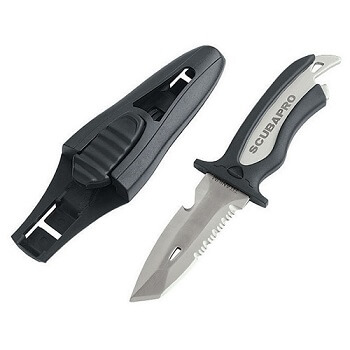 Another popular material for dive knife blades is hardened titanium. A titanium dive knife blade is completely corrosion-resistant, it is lightweight yet extremely strong, and it can hold a sharp edge for a long, long time, all of which make titanium dive knives excellent cutting tools for use in saltwater environments. The lightweight, multi-function X-Cut titanium dive knife is an excellent example of a titanium cutting tool. Measuring just under 13 centimeters in overall length, its 6.3 centimeter blade is specially designed to maintain a highly-durable cutting edge for a long life of corrosion-free performance
Another popular material for dive knife blades is hardened titanium. A titanium dive knife blade is completely corrosion-resistant, it is lightweight yet extremely strong, and it can hold a sharp edge for a long, long time, all of which make titanium dive knives excellent cutting tools for use in saltwater environments. The lightweight, multi-function X-Cut titanium dive knife is an excellent example of a titanium cutting tool. Measuring just under 13 centimeters in overall length, its 6.3 centimeter blade is specially designed to maintain a highly-durable cutting edge for a long life of corrosion-free performance
Diver's Knife Cutting Edges, Tips and More
Dive knife blades come with either a plain edge, a serrated edge or a combination of both to handle a variety of cutting jobs.
A plain edge is good for making clean slicing cuts, or when using more of a pushing motion when control and accuracy are required – like filleting a fish. This type of cutting motion is especially effective if the cutting edge is curved. Plain edges are also easy to maintain. Anyone with a basic sharpening tool can keep a plain edge razor sharp with little effort.
A serrated edge has a series of mini-edges or teeth similar to a hand saw. A serrated edge is great for sawing-type cuts through heavy materials like wood or rope or stubborn kelp fronds. For example, using a plain edge it would take forever to cut through a three-quarter inch anchor line, but a serrated edge would make quick work of it as the teeth bite deep into the material with every sawing motion. A serrated edge also stays sharp for much longer than a plain edge, but it is a bit more difficult to sharpen.
Because these different blade edges excel in cutting different types of materials, most dive knives offer both, often on the same cutting plane. Normally, the plain edge can be found closer to the tip of the blade, beneath the curve or "belly" of the blade, whereas the serrated portion can be found closer to the handle for better leverage when leaning into the tougher cuts.
Since a scuba diver's knife blade's cutting efficiency increases in relation to its length, dive knives that sport long blades, like the TK15 and K6, separate their cutting edges, devoting the entire top length of the blade to serration, and the entire bottom length to the plain edge. This maximizes the length of each cutting edge and the overall efficiency of the knife.
When it comes to blade tips, dive knives normally come with either a blunt tip, a tanto tip, or some variation of a pointed tip.
On one end of the spectrum is the blunt tip. As its name implies, the blunt tip is flat and dulled. It is designed to be more of a prying tip than a piercing tip. It is considered safer than other tips because you can't accidentally stab your leg or puncture your BCD when returning it to its sheath.
On the other end of the spectrum is the pointed tip. These tips come in a variety of shapes. For example, the TK15 comes with a drop-point tip. This is where the blade's upper edge, or spine, gradually "drops" as it reaches the tip of the blade to form the tip. This is considered a strong tip that is easy to control when cutting or piercing.
 The K6 and X-Cut have clip-point tips, so-named because the spine of the blade is "clipped" as it approaches the tip. This creates a narrow tip that can be very useful for piercing a line wrapped tightly around a boat propeller in preparation for a slicing or sawing cut. While not quite as strong as the drop-point, the clip-point is considered a very sharp and controllable point.
The K6 and X-Cut have clip-point tips, so-named because the spine of the blade is "clipped" as it approaches the tip. This creates a narrow tip that can be very useful for piercing a line wrapped tightly around a boat propeller in preparation for a slicing or sawing cut. While not quite as strong as the drop-point, the clip-point is considered a very sharp and controllable point.
Falling in between the blunt tip and pointed tip is the tanto tip. Combining elements of blunt and pointed, the typical tanto tip offers more of an angled tip which is sharpened for cutting, like on the Mako. However, sometimes the tanto tip provides a small blunt spot as well, like you'll find on the White Tip. Both versions produce a very strong and durable tip, enabling you to do a little prying with less chance of snapping the tip, with the added ability do some cutting when working in tight spaces.
Most dive knife blades also include a notch for cutting fishing line. And, depending on design, you can sometimes find additional tools like a bottle opener (Mako), a stainless steel handle-end for hammering (K6) or a shackle key (TK15).
The Best Dive Knives?
So which diving knife do you choose? Like with most types of scuba equipment, the ideal scuba knife depends on your individual diving style – how you dive, where you dive, what you like to do while at depth, and how you like to carry your gear. The choices are many. The good news is that with the variety of dive knives available in different sizes, shapes, materials and mounting options, finding the best dive knife to suit your unique scuba diving needs shouldn't be too difficult. Your perfect diving knife – or alternative cutting tool – is out there, waiting for you to strap it on and go diving.
